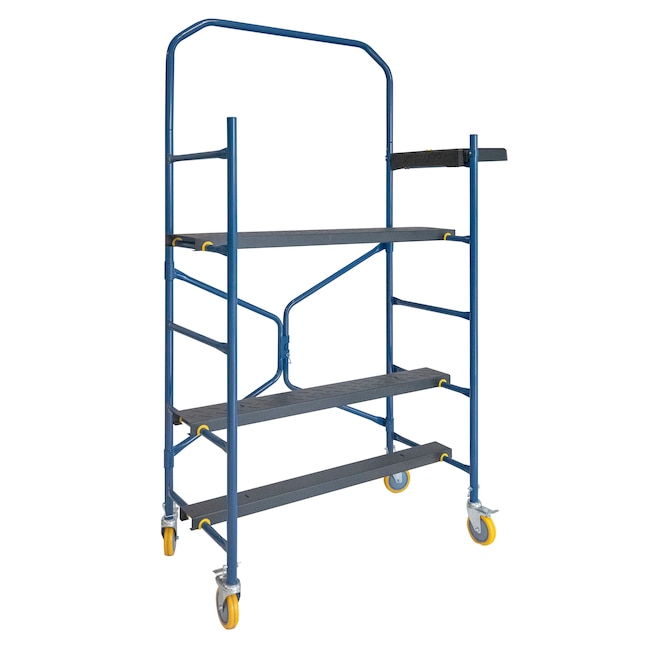Checking Out the Numerous Sorts Of Scaffolding Utilized in Building And Construction Tasks
The building and construction industry depends greatly on different kinds of scaffolding to fulfill particular job needs, each offering distinctive advantages and applications. Standard structure scaffolding provides a sturdy foundation for general jobs, while put on hold scaffolding is essential for work on high-rise structures.

Typical Frame Scaffolding
Traditional structure scaffolding is among one of the most commonly utilized approaches in the building and construction market due to its robustness and convenience. This system consists of horizontal and upright frameworks that are assembled to develop a secure system for employees and products. The main elements include upright messages, straight ledgers, and diagonal dental braces, which with each other provide a solid structure that can sustain considerable lots.
One of the essential benefits of conventional framework scaffolding is its flexibility to numerous building tasks, varying from residential structures to big commercial structures. The modular style permits very easy assembly and disassembly, making it efficient for both lasting and temporary projects. Additionally, the system can be tailored in elevation and size, accommodating different building layouts and website problems.
Security is paramount in scaffolding applications, and standard structure systems are equipped with guardrails and toe boards to prevent falls and make sure worker defense. Additionally, routine assessments and adherence to safety and security policies are important in preserving the stability of the scaffold. On the whole, typical structure scaffolding continues to be a basic option in the building market, offering a trustworthy system for labor and improving total task effectiveness

Suspended Scaffolding
Suspended scaffolding supplies a special solution for building projects that require accessibility to raised surface areas, particularly in scenarios where standard frame scaffolding may be not practical. This sort of scaffolding is typically suspended from the roof covering or upper levels of a framework, utilizing a system of wheels, platforms, and ropes to produce a functioning space that can be gotten used to numerous elevations.
One of the main benefits of put on hold scaffolding is its adaptability. It can be quickly repositioned or decreased to suit adjustments in building and construction requirements, making it ideal for tasks such as home window installation, façade job, and upkeep on high-rise buildings. Additionally, the very little impact of put on hold scaffolding enables better use ground space in metropolitan settings, where room is usually limited.
Security is an important consideration in the use of put on hold scaffolding. Overall, put on hold scaffolding supplies a effective and effective remedy for accessing hard-to-reach areas in various construction scenarios, boosting both productivity and safety and security on site.
System Scaffolding
System scaffolding, typically considered a contemporary service in the scaffolding industry, includes pre-engineered components that can be promptly constructed and adjusted for different building and construction jobs. Scaffolding. read what he said This sort of scaffolding is identified by its modular design, which permits flexibility and efficiency on work sites, suiting different elevations and architectural needs
Normally made from high-strength steel or aluminum, system scaffolding provides boosted sturdiness and stability. The elements consist of vertical blog posts, horizontal journals, and angled braces, which adjoin securely, making sure a durable structure. The style commonly incorporates standardized installations, simplifying setting up and disassembly processes, thus lowering labor time and costs.

Rolling Scaffolding
Moving scaffolding is a functional choice to standard fixed scaffolding, made for wheelchair and convenience of use on building sites. This sort of scaffolding contains a platform sustained by frameworks with wheels, enabling employees to conveniently move it as required. The movement feature significantly improves productivity, as it lessens downtime related to dismantling and constructing dealt with scaffolding.
Usually built from light-weight materials such as aluminum or steel, rolling scaffolding provides a durable yet mobile solution for tasks requiring regular repositioning - Scaffolding. It is particularly helpful in tasks such as paint, drywall installation, and electrical job, where accessibility scaffold flutter to various elevations and areas is required
Security is critical in rolling scaffolding style, with attributes such as locking wheels to protect against unexpected activity when in use, and guardrails to safeguard workers from falls. In addition, numerous designs are flexible in height, suiting numerous project needs.
Cantilever Scaffolding

The style of cantilever scaffolding commonly entails using braces or arms anchored to a building or structure, allowing the platform to extend outside securely. Safety is extremely important; hence, these scaffolds should be crafted to endure various loads and ecological problems. Routine inspection and maintenance are vital to ensure architectural integrity and worker safety.
Cantilever scaffolding is preferred for its adaptability and reliable use area, making it a prominent selection in urban atmospheres where room restrictions prevail. Additionally, it facilitates simpler accessibility to high elevations, eventually adding to the overall effectiveness of building and construction jobs. Just like all scaffolding kinds, correct training and adherence to safety standards are important for employees using cantilever scaffolding.
Final Thought
Standard frame scaffolding supplies stability, while put on hold scaffolding uses flexibility for elevated tasks. System scaffolding promotes fast assembly, and rolling scaffolding improves mobility for differing work environments.
Conventional frame scaffolding provides a strong foundation for basic jobs, while put on hold scaffolding is necessary for work on skyscraper structures.Rolling scaffolding is a versatile option to conventional set scaffolding, created for mobility and convenience of usage on building websites. As with all scaffolding kinds, correct training and adherence to safety criteria are essential for workers using cantilever scaffolding.
Conventional structure scaffolding offers security, while put on hold scaffolding provides convenience for elevated jobs. System scaffolding promotes fast setting up, and rolling scaffolding enhances wheelchair for varying work settings.